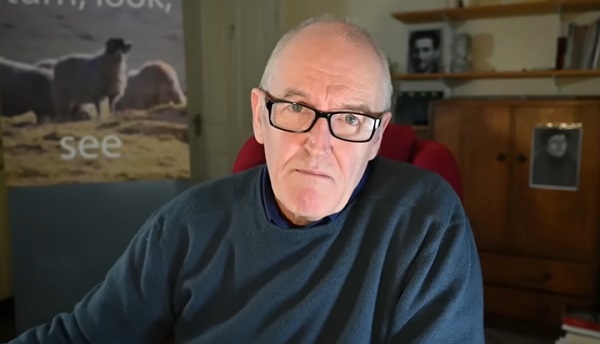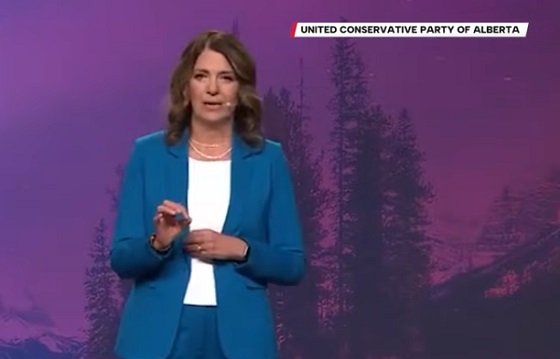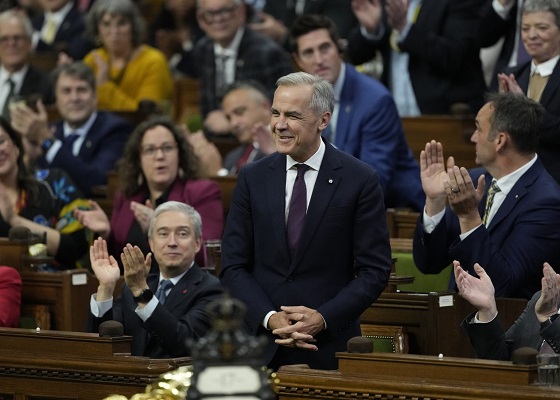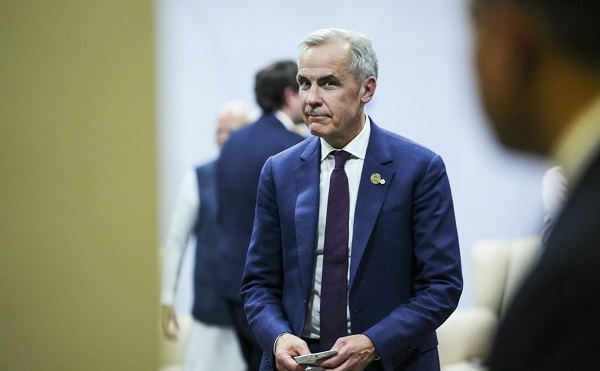Brownstone Institute
Did Lockdowns Signify the “End of Abundance?”

From the Brownstone Institute
BY
French President Emmanuel Macron gave a speech not long ago in which he made a rather shocking prediction about the future of his nation and presumably the rest of the world.
“What we are currently living through is a kind of major tipping point or a great upheaval … we are living the end of what could have seemed an era of abundance … the end of the abundance of products of technologies that seemed always available … the end of the abundance of land and materials including water….”
The G7 leader’s words of warning about the literal end of material prosperity caught my eye in a way that most headlines do not. I also noticed that Paris switched off the lights on the Eiffel Tower to save a meager amount of electricity, providing a potent symbol to underscore Macron’s message about the “End of Abundance.”
In this era of economic chaos, disrupted supply chains, ruinous inflation, a severe energy crunch in Europe, tensions between nuclear superpowers, and extreme political polarization, plus intense worries (in some quarters, at least) about climate change, there are emerging signs of a belief in the once unthinkable: the possibility that Progress with a capital “P” may no longer be assured.
It should be obvious at this point that Covid-19 lockdowns and related pandemic policies, including the printing of trillions of dollars to paper over the intentional disruption of society, played a major role in bringing about today’s negative economic conditions. These conditions could last a very long time, particularly considering the mild political blowback to Covid chaos that we saw during the midterm elections. Brownstone’s Jeffrey Tucker has written about the potentially far-reaching effects of lockdowns:
“But what if we aren’t really observing a cycle? What if we are living through a long shock in which our economic lives have been fundamentally upended? What if it will be many years before anything that we knew as prosperity returns if it ever does? … In other words, it is very possible that the lockdowns of March 2020 were the starting point of the greatest economic depression in our lifetimes or perhaps in hundreds of years.”
The worst depression in hundreds of years? That would be since the beginning of the Industrial Revolution, more or less. The Bank of England, incidentally, just warned that the UK is facing the longest recession since records began. The historical forces we are living through now might be so big that most of us might not even recognize them until much later.
Taking the long view, we should ask ourselves: were lockdowns the initial cause of the chaos we are experiencing, or were they the unfortunate result of a larger historical phenomenon that we are just now beginning to understand? As Tucker noted, “[i]n the 1930s, no one knew that they were living through what came to be called the Great Depression.” So it is fair to ask, would you know if lockdowns were the first crisis of an era that will one day come to be called the “End of Abundance?”
Thinking the Unthinkable
The “End of Abundance” is a radical concept, but then again so is shutting down the whole world.
The utterly radical nature of the ideas that gave rise to Covid-19 lockdowns are striking. In August of 2020, Anthony Fauci wrote that the goal of his policies was nothing less than to “rebuild the infrastructure of human existence.”
During that time we heard the constant refrain from Joe Biden, Boris Johnson, and other world leaders: “Build Back Better.” And from the Davos technocrats at the World Economic Forum (WEF) we have heard talk of the “Fourth Industrial Revolution,” which to them means “merging the physical, digital and biological world” in order to fundamentally change “what it means to be human.”
Locking down the population and subjecting it to draconian restrictions is, for some reason, absolutely central to their vision of changing “what it means to be human.” Bill Gates and other influential elites have pointed to the Covid-19 response as their template for addressing future challenges, and have even floated the possibility of future climate lockdowns (no, sadly this is not a conspiracy theory).
The million-dollar question that many have tried to answer is, “Why now?” Why, at this point in history, do elites insist on the power to lock down the world? Why, after decades of post-World War Two prosperity, have so many abandoned values that are fundamental to our civilization? Why, in the second decade of the 21st century, are we taking a nosedive off the elevator of “Progress?”
There is no shortage of theories as to “Why now?” There are many critics of the WEF’s “Fourth Industrial Revolution” and the “Great Reset,” for example, who say that elites have cooked up imaginary challenges like climate change and “saving the planet” as excuses for the exercise of tyrannical power, in what amounts to a big scam.
I am not satisfied with those kinds of answers, even though I think they contain elements of truth, given that elites obviously use certain issues as a pretext. To my mind, environmental concerns definitely are not a scam (although the “solutions” often are). What has been happening since March 2020 is much bigger than a scam. The radical ideas underlying the lockdown mentality simply must have a more radical motivation behind them. These people literally just tried to shut down the entire world and reboot it like a malfunctioning computer!
If you are looking for the most profound motivation possible for the incredibly radical lockdown mentality and the vast destruction it has wrought, I would submit that you could do no better than the “End of Abundance.” And what does “Abundance” mean exactly? I think it can be summarized in a single word: Growth. The “End of Abundance” means the End of Growth.
Imagining Limits to Growth
“We don’t know how to make a zero-growth society work,” conservative tech billionaire Peter Thiel said in an interview for Unherd, in which he claimed that Covid-19 lockdowns resulted from the long-term stagnation of growth and innovation in our society. His argument is that as society has slowly stagnated over the past several decades, we have tacitly abandoned the aspiration to growth, leading to a sort of malaise that has “resulted in something like a societal and cultural lockdown; not just the last two years but in many ways the last 40 or 50.”
Thiel contends that limits to growth are not inevitable, but that the belief in limits is a kind of self-fulfilling prophecy. He calls this “a long, slow victory of the Club of Rome,” the global think tank that published the famous book—some would call it infamous—The Limits to Growth fifty years ago.
His statement “We don’t know how to make a zero-growth society work” is spot on. Limits of any kind are anathema to growth-based, industrially developed countries in which everything is built on the premise of perpetual growth.
This is why, for most people, the end of economic growth is absolutely unimaginable. But not for everyone.
For me, the end of growth has been something of a preoccupation for about ten years, since I first read The Limits to Growth. My reaction to the book was similar to Thiel’s only in the sense that I agree that the end of growth would be a cataclysm for our growth-based society. Unlike him, I do not see the limits to growth as merely a self-fulfilling prophecy, but rather as an accurate description of the very real physical and biological limits of a finite planet.
The premise of The Limits to Growth, based on a major study conducted by researchers at the Massachusetts Institute of Technology (MIT), is that natural resources and the capacity of the planet to absorb industrial pollution are limited, and therefore infinite economic growth on a finite planet is impossible. The original study, which has been reviewed and updated over the years, projected various scenarios in which an end to growth of the global industrial economy—a long-term decline in industrial output, the availability of non-renewable natural resources, industrial pollution, food production, and population—would start at some point in the first one-third to one-half of the 21st century. Right about now.
The Limits to Growth was extremely controversial from the moment it was published. Prominent Western leaders attacked the notion of limits as a dangerous delusion. The Right refused to accept limits, believing that human ingenuity and technological innovation will always overcome whatever ecological limits exist.
After briefly preaching limits, the progressive Left abandoned that faith, too, and now believes that limits can be overcome with some combination of activist government and “green” technologies like solar panels and wind turbines (e.g. the “Green New Deal”). Even climate-change models that predict catastrophic levels of warming this century assume global GDP growth through the year 2100.
The vast majority of people in our society, both Right and Left, have never taken the idea of limits to growth seriously. But what if you are in that small group of people who have taken the concept seriously? And what if you have stuck to the basic belief that infinite growth on a finite planet is impossible? What might you have expected to see at this point in the 21st century?
Chaos, essentially. The breakdown of the social contract. Civil strife. A mental-health crisis. Declining life expectancy. The spread of irrational beliefs. The destructive urge to tear down rather than build up. Dangerous levels of inflation. A global food crisis. People eating crickets and drinking cockroach milk. The extinction of two-thirds of the Earth’s wildlife. The disruption of fragile supply chains. The rapid accumulation of debts.
The printing of vast amounts of money. A quarter of American adults so stressed they cannot function. Plastic pollution (like five billion Covid masks) filling the oceans. Wildfires and floods. Diesel fuel shortages. Unprecedented financial and economic dislocations. Scary new terms like “poly-crisis.” Desperate grasping for solutions. Warnings from the United Nations that we are at risk of “total societal collapse” due to climate change, ecosystem failure, and economic fragility, and urging the “rapid transformation of societies”. Add to that list a procession of global leaders making strange, grandiose declarations about the need to “rebuild human existence” and “change what it means to be human.”
In other words, if you were waiting for the limits to growth to start kicking in at this point in the second decade of the 21st century, you might have expected to see the kinds of disturbing things that we have been witnessing in recent years. Dennis Meadows, lead author of The Limits to Growth, has said that the projections of his fifty-year-old study “resemble what we are experiencing” in the world currently.
Meadows has not criticized Covid lockdowns, but he has confirmed that his study showed “growth was going to stop around 2020”—the year that the whole world just happened to shut down—and would be accompanied by all sorts of unpredictable and potentially extreme “psychological, social, and political factors.” It should be further noted that the head of the International Monetary Fund, Kristalina Georgieva, gave a speech on October 1, 2019, mere months before global lockdowns, in which she warned of a “synchronized slowdown” of the global economy covering “90 percent of the world,” creating “a serious risk that services and consumption could soon be affected.”
The coincidences in timing are remarkable. The predicted end of growth, an actual slowdown in global growth, and the lockdown of the entire globe all converged in 2020. Does this necessarily mean The Limits to Growth was right, or that lockdowns were a direct response to limited growth? No, but again the current state of the world is eerily consistent with the pandemonium that you might have expected had you taken the concept of limits to growth seriously.
Speaking for myself, when I first became aware of the implications of the limits to growth in 2014 and 2015, I told my close friends and family, “The 2020s will be chaotic.” Three months into the start of the new decade, when the whole world suddenly came to a grinding halt, I began to recall the prediction I had made. Three years into one of the most chaotic decades in history, I am beginning to worry that I was onto something.
Interestingly, whether you believe that biological and physical limits to growth truly exist, as I do, or you believe that limits to growth are merely a figment of some fevered Malthusian imagination that has somehow manifested itself in the real world, as Thiel seems to think, the result is arguably the same: the “End of Abundance.”
Limits and Lockdowns
Thiel is not the only one who has linked lockdowns to the limits to growth. While almost everyone on the environmental Left supported lockdowns or at least refrained from speaking out against them, there are a handful of heterodox environmental thinkers—those who tend to be skeptical of partisan narratives, corporate power, and technocratic “solutions”—who have connected the dots between limits and lockdowns.
The British novelist and essayist Paul Kingsnorth, for example, has written that “we have no idea what to do about the coming end of the brief age of abundance, and the reappearance, armed and dangerous, of what we could get away with denying for a few decades: limits.”
Kingsnorth, an Orthodox Christian and an unorthodox environmentalist (he calls himself a “recovering environmentalist”), has vigorously criticized the technocratic response to the pandemic, observing that Covid “was used as a trial run for precisely the kind of technologies…which are now increasingly sold to us as a means of ‘saving the planet.’” He says that the Brave New World that the technocrats are trying to build, with its machine-like desire to exert control over everyone and everything, is unable to recognize limits of any kind, whether natural or moral.
Professor Jem Bendell of the University of Cumbria is one of the few on the environmental Left who has spoken out against authoritarian Covid policies. He is known for his “Deep Adaptation” paper describing the severe disruptions to society that he believes will result from climate change. He has criticized lockdowns, mandates, and other non-democratic responses to the pandemic, suggesting they are a form of “Elite Panic”—a panicked reaction of a social elite to a disaster event, with a focus on measures of command and control—which parallels a potentially similar panic among elites regarding climate change that “could inspire leaders to curtail personal freedoms.”
Panic, the desire for control, and the curtailment of personal freedoms. Yes, I find that to be a very good summary of the story we have been living for two and a half years.
If we dig deeper into the assumptions and beliefs of Western elites, it becomes clear that they are afraid that the global economy, especially their own way of life, is threatened by “limiting” factors. This fear is a driving force behind their support for lockdowns and other radical ideas they have concocted in an attempt to overcome those limits and protect themselves. Panicking elites in Western society may not specifically believe in the “limits to growth,” or use those words, but they feel in their bones that systemic global risks are getting worse.
Lockdowns, it is crucial to recognize, are not a mere sideshow in the “End of Abundance” drama. They play a starring role. Remember, as Thiel said, we do not know how to make a no-growth or even a low-growth society work. Only through some radical new approach to governance can a stagnant or declining economy be managed.
When the economic pie is growing everyone can get a larger slice, but when the pie is shrinking everyone must share the pain, unless a small number of powerful people find a way to seize a bigger slice of a smaller pie at the expense of everyone else. That is what lockdowns were all about.
Lockdowns and “The Mindset” for Coping with the “End of Abundance”
In the novel, Gone with the Wind, the Southern aristocrat Rhett Butler described his philosophy of profiting from the disintegration of the Old South. “I told you once before that there were two times for making big money,” he said to Scarlett, “one in the up-building of a country and the other in its destruction. Slow money on the up-building, fast money in the crack-up.”
Western elites appear to have a similar attitude toward the “crack-up” of the Old Normal.
For years the elite Davos crowd has been active in making plans for the end of the world as we know it. They have extensive plans to profit from “green” energy and other ostensibly “sustainable” responses to environmental limits: insect protein, fake meat, gene-edited crops, factory foods, capture of carbon dioxide, etc. They also tend to own “doomsday” compounds and underground bunkers—Thiel has a luxury bolthole in New Zealand—and spend substantial time and resources planning for catastrophic end-of-civilization scenarios.
The Italian scientist Ugo Bardi, a member of the Club of Rome who co-edited the fifty-year update to The Limits to Growth, has compared bunker-owning elites to those of the collapsing Roman Empire. “We see a pattern,” he says. “When the rich Romans saw that things were going really out of control, they scrambled to save themselves while, at the same time, denying that things were so bad.” Many elites fled to their bunkers during the pandemic, as Covid-19 brought their long-simmering fears of social disruption to the forefront.
Technology writer Douglas Rushkoff’s recent book, Survival of the Richest, documents in detail the habits of mind of uber-elites who have been prepping for social collapse. His book is based on a talk he was invited to give to a group of five ultra-wealthy men, including two billionaires, in 2017. Rushkoff thought he had been invited to speak about the future of technology, so he was surprised when the men only wanted to ask questions about something they called “The Event.”
“The Event,” wrote Rushkoff. “That was their euphemism for the environmental collapse, social unrest, nuclear explosion, unstoppable virus, or Mr. Robot hack that takes everything down.” Read that again. Unstoppable virus. This was over two years before Covid-19.
The five powerful men’s interest revolved around a key question asked by one of them, the CEO of a brokerage house. He was desperate to know, “How do I maintain authority over my security force after The Event?”
“This single question occupied up for the rest of the hour . . . . [H]ow would he pay the guards once even his crypto was worthless? What would stop the guards from eventually choosing their own leader?
The billionaires considered using special combination locks on the food supply that only they knew. Or making guards wear disciplinary collars of some kind in return for their survival. Or maybe building robots to serve as guards and workers – if that technology could be developed “in time.”
I tried to reason with them. I made pro-social arguments for partnership and solidarity as the best approaches to our collective, long-term challenges . . . . They rolled their eyes at what must have sounded to them like hippy philosophy.
Rushkoff calls the outlook of these five men—a representative slice of the power elite in Silicon Valley, Wall Street, Washington, DC, and Davos—The Mindset. “The Mindset,” he writes, “allows for the easy externalization of harm to others, and inspires a corresponding longing for transcendence and separation from the people and places that have been abused.” Those with The Mindset, he says, believe that they can use their wealth, power, and technology to somehow “leave the rest of us behind.”
Does The Mindset sound familiar? It should, because it is a great description of how global elites (and their white-collar functionaries in the laptop class) responded to Covid-19. They pushed all the pain of locking down society onto average people, while seeking to avoid the catastrophic consequences. (Rushkoff has not criticized Covid-19 lockdowns in these terms, as far as I can tell, even though he deftly described “The Mindset” behind them).
In 2020 and 2021, the richest and most powerful huddled in their luxury compounds as they used their influence to shut down large swathes of society and declare a “high-tech war” on the virus.
The world’s ten richest men literally doubled their massive personal fortunes in one year, as did Fauci—“fast money on the crack-up” remember—even as their lockdowns caused economic conditions to crater, undermining everyone’s prospects over the longer term, including their own. Average people suffered the collateral damage of a non-functioning world. Hundreds of millions of people worldwide were pushed into hunger and dire poverty.
In short, a powerful class of panicked elites used lockdowns to seize larger slices of a shrinking pie, and they used technology to keep the masses from getting too rowdy as their slices got smaller. The tech-enabled social controls that regular citizens were subjected to—contact tracing apps, QR codes, vaccine passports, social-media censorship, etc.—served as the sort of technological “disciplinary collar” that the men at Rushkoff’s meeting had dreamed of.
Lockdowns were a perfect expression of The Mindset for handling a major disruption to the global economy that prevails in ultra-elite circles (no, this is not a “conspiracy theory,” it is just how these people think). And like it or not, most of the people in these circles believe that humanity is now faced to one degree or another with the mother of all crises: the “End of Abundance.”
They are looking to a future of lockdowns, mandates, mass surveillance, censorship, underground bunkers, fake meat, factory-farmed bugs, and digital “disciplinary collars” as they “change what it means to be human” and “rebuild the infrastructure of human existence.”
These are not the words, ideas, and plans of confident leaders who believe in a bright future for their people. These are the words, ideas, and plans of self-interested leaders who are preparing to profit from a dystopian future of some kind, and above all to protect themselves.
This is the kind of thinking that attends the decline or collapse of a nation, empire, or civilization. If Western leaders had confidence in a future of robust growth, they would not be trying so furiously to tear down existing social, economic, and cultural arrangements and build them back “Better.”
How to Respond to the “End of Abundance?”
So what is the correct response to the potential “End of Abundance” and the lockdown mentality it has spawned? Right now, there are two general responses.
Those who resisted Covid-19 lockdowns, mostly on the Right, want to beat back the worst excesses of the New Normal. They have been disappointed by the relatively mild political blowback to the Covid fiasco, and ultimately hope for a political movement that will facilitate a return to a golden age of post-World War Two growth, freedom, and the American Dream. The last thing they want to do is give the people who foisted lockdowns on us more power, or adapt to a world of no growth.
Those on the progressive Left who supported lockdowns actually long for a New Normal. They are losing sleep about climate change, Covid-19, new pandemics, worsening inequality, the dreaded MAGAs, and an uncertain future. They are believers in the Brave New World sold to them by the woke technocrats. Progressives believe that future limitations can be overcome if we trust “Experts” and “The Science” and mercilessly punish “Deniers.”
Can either of these strategies prevail? The Right’s strategy of returning to the good ‘ol days neglects the fact that social, economic, and environmental conditions have drastically deteriorated in the last 50 years. This deterioration is precisely why most Western elites and virtually all of the biggest players in the market—Big Tech, Big Pharma, Big Finance, Big Media, Big Ag—have gotten on board with the New Normal, i.e. profiting from some kind of crack-up of the Old Normal.
The Left’s strategy of trusting in new technologies and grand central plans is no more realistic. “Green” energy cannot “solve” climate change because it is probably impossible to convert the world to green energy, or power the economy with it, and attempting to do so would itself cause enormous damage to the planet. All the elaborate technocratic plans for saving the planet—smart cities, cricket cakes, solar farms, sun-reflecting chemical clouds, social credit systems, misinformation task forces, stay-at-home orders—will surely solve nothing and can only bring about a centralized tech-enabled dystopia that primarily benefits elites.
Personally, I am sticking with the view that The Limits to Growth got it pretty much right fifty years ago. Infinite growth on a finite planet is impossible. Nothing can change that. Not “The Science,” not the “Free Market,” not the “Green New Deal,” not the “Great Reset,” not Lockdowns, and not any technology, ideology, grandiose philosophy, or radical scheme. This fundamental reality—the clash between our finite existence and our infinite material ambitions—is why we are in an unprecedented social, economic, and ecological crisis.
And even if I am wrong about that, “The Mindset” of a panicked elite class which no longer believes in a future worth striving for, and which aims primarily to protect itself at the expense of everyone else, virtually ensures societal decline. “Great civilizations die by suicide,” wrote the famed historian Arnold Toynbee, an act that he said was usually committed by a small class of elites who shift from leading to “dominating” everyone else.
So I cannot imagine a lasting return to the Golden Age of growth that conservatives dream of, or the birth of a Brave New World that progressives fantasize about. I think we will all be living in a world that few dream of and even fewer fantasize about: a world of limits.
As Paul Kingsnorth has written, “[w]hatever we think our politics are…we have no idea what to do” about the problem of limits. To the extent any positive outcome is possible, I think it can only emerge from a long, slow process of decentralization. As the global economy strains under the weight of limits, a network of local economies, cultures, and political systems may arise that will serve human needs, and the needs of the planet, better than the centralized dystopia that most Western elites envision.
If some sort of humane decentralized response to a world of limits fails to emerge, we have already had a preview over the last two and a half years of a centralized response to the “End of Abundance.” As Macron put it in his speech, “Freedom has a cost.” He and his allies in the halls of power intend to eliminate that cost from their bottom line. This is their only vision for a future of limits.
But perhaps you feel that all talk about “limits to growth” or the “End of Abundance” is hogwash. Maybe you are convinced that anything less than growth forever and ever is unthinkable. Maybe you believe that the global economy will triple in size over the next three decades and US GDP will smoothly expand from $25 trillion to nearly $75 trillion by 2052 (with a serviceable $140 trillion national debt), as the Congressional Budget Office projects, without any serious damage to the planet or nasty “Fourth Industrial Revolution” to spoil the fun.
Over the long term, regardless of temporary ups and downs, the underlying realities that gave rise to the radical lockdown “Mindset” are not going away. If your understanding of freedom, democracy, and the good life depends on perpetual growth, the constant march of Progress, and ever-rising material standards of living, I hope that you do not eventually find yourself with no choice but to open wide, hold your nose, and eat the bugs.
Better to swallow the bitter reality of limits.
Of course, I could be wrong. Maybe infinite growth on a finite planet is possible, and a return to a golden age of growth is just around the corner.
Brownstone Institute
The Unmasking of Vaccine Science

From the Brownstone Institute
By
I recently purchased Aaron Siri’s new book Vaccines, Amen. As I flipped though the pages, I noticed a section devoted to his now-famous deposition of Dr Stanley Plotkin, the “godfather” of vaccines.
I’d seen viral clips circulating on social media, but I had never taken the time to read the full transcript — until now.
Siri’s interrogation was methodical and unflinching…a masterclass in extracting uncomfortable truths.
A Legal Showdown
In January 2018, Dr Stanley Plotkin, a towering figure in immunology and co-developer of the rubella vaccine, was deposed under oath in Pennsylvania by attorney Aaron Siri.
The case stemmed from a custody dispute in Michigan, where divorced parents disagreed over whether their daughter should be vaccinated. Plotkin had agreed to testify in support of vaccination on behalf of the father.
What followed over the next nine hours, captured in a 400-page transcript, was extraordinary.
Plotkin’s testimony revealed ethical blind spots, scientific hubris, and a troubling indifference to vaccine safety data.
He mocked religious objectors, defended experiments on mentally disabled children, and dismissed glaring weaknesses in vaccine surveillance systems.
A System Built on Conflicts
From the outset, Plotkin admitted to a web of industry entanglements.
He confirmed receiving payments from Merck, Sanofi, GSK, Pfizer, and several biotech firms. These were not occasional consultancies but long-standing financial relationships with the very manufacturers of the vaccines he promoted.
Plotkin appeared taken aback when Siri questioned his financial windfall from royalties on products like RotaTeq, and expressed surprise at the “tone” of the deposition.
Siri pressed on: “You didn’t anticipate that your financial dealings with those companies would be relevant?”
Plotkin replied: “I guess, no, I did not perceive that that was relevant to my opinion as to whether a child should receive vaccines.”
The man entrusted with shaping national vaccine policy had a direct financial stake in its expansion, yet he brushed it aside as irrelevant.
Contempt for Religious Dissent
Siri questioned Plotkin on his past statements, including one in which he described vaccine critics as “religious zealots who believe that the will of God includes death and disease.”
Siri asked whether he stood by that statement. Plotkin replied emphatically, “I absolutely do.”
Plotkin was not interested in ethical pluralism or accommodating divergent moral frameworks. For him, public health was a war, and religious objectors were the enemy.
He also admitted to using human foetal cells in vaccine production — specifically WI-38, a cell line derived from an aborted foetus at three months’ gestation.
Siri asked if Plotkin had authored papers involving dozens of abortions for tissue collection. Plotkin shrugged: “I don’t remember the exact number…but quite a few.”
Plotkin regarded this as a scientific necessity, though for many people — including Catholics and Orthodox Jews — it remains a profound moral concern.
Rather than acknowledging such sensitivities, Plotkin dismissed them outright, rejecting the idea that faith-based values should influence public health policy.
That kind of absolutism, where scientific aims override moral boundaries, has since drawn criticism from ethicists and public health leaders alike.
As NIH director Jay Bhattacharya later observed during his 2025 Senate confirmation hearing, such absolutism erodes trust.
“In public health, we need to make sure the products of science are ethically acceptable to everybody,” he said. “Having alternatives that are not ethically conflicted with foetal cell lines is not just an ethical issue — it’s a public health issue.”
Safety Assumed, Not Proven
When the discussion turned to safety, Siri asked, “Are you aware of any study that compares vaccinated children to completely unvaccinated children?”
Plotkin replied that he was “not aware of well-controlled studies.”
Asked why no placebo-controlled trials had been conducted on routine childhood vaccines such as hepatitis B, Plotkin said such trials would be “ethically difficult.”
That rationale, Siri noted, creates a scientific blind spot. If trials are deemed too unethical to conduct, then gold-standard safety data — the kind required for other pharmaceuticals — simply do not exist for the full childhood vaccine schedule.
Siri pointed to one example: Merck’s hepatitis B vaccine, administered to newborns. The company had only monitored participants for adverse events for five days after injection.
Plotkin didn’t dispute it. “Five days is certainly short for follow-up,” he admitted, but claimed that “most serious events” would occur within that time frame.
Siri challenged the idea that such a narrow window could capture meaningful safety data — especially when autoimmune or neurodevelopmental effects could take weeks or months to emerge.
Siri pushed on. He asked Plotkin if the DTaP and Tdap vaccines — for diphtheria, tetanus and pertussis — could cause autism.
“I feel confident they do not,” Plotkin replied.
But when shown the Institute of Medicine’s 2011 report, which found the evidence “inadequate to accept or reject” a causal link between DTaP and autism, Plotkin countered, “Yes, but the point is that there were no studies showing that it does cause autism.”
In that moment, Plotkin embraced a fallacy: treating the absence of evidence as evidence of absence.
“You’re making assumptions, Dr Plotkin,” Siri challenged. “It would be a bit premature to make the unequivocal, sweeping statement that vaccines do not cause autism, correct?”
Plotkin relented. “As a scientist, I would say that I do not have evidence one way or the other.”
The MMR
The deposition also exposed the fragile foundations of the measles, mumps, and rubella (MMR) vaccine.
When Siri asked for evidence of randomised, placebo-controlled trials conducted before MMR’s licensing, Plotkin pushed back: “To say that it hasn’t been tested is absolute nonsense,” he said, claiming it had been studied “extensively.”
Pressed to cite a specific trial, Plotkin couldn’t name one. Instead, he gestured to his own 1,800-page textbook: “You can find them in this book, if you wish.”
Siri replied that he wanted an actual peer-reviewed study, not a reference to Plotkin’s own book. “So you’re not willing to provide them?” he asked. “You want us to just take your word for it?”
Plotkin became visibly frustrated.
Eventually, he conceded there wasn’t a single randomised, placebo-controlled trial. “I don’t remember there being a control group for the studies, I’m recalling,” he said.
The exchange foreshadowed a broader shift in public discourse, highlighting long-standing concerns that some combination vaccines were effectively grandfathered into the schedule without adequate safety testing.
In September this year, President Trump called for the MMR vaccine to be broken up into three separate injections.
The proposal echoed a view that Andrew Wakefield had voiced decades earlier — namely, that combining all three viruses into a single shot might pose greater risk than spacing them out.
Wakefield was vilified and struck from the medical register. But now, that same question — once branded as dangerous misinformation — is set to be re-examined by the CDC’s new vaccine advisory committee, chaired by Martin Kulldorff.
The Aluminium Adjuvant Blind Spot
Siri next turned to aluminium adjuvants — the immune-activating agents used in many childhood vaccines.
When asked whether studies had compared animals injected with aluminium to those given saline, Plotkin conceded that research on their safety was limited.
Siri pressed further, asking if aluminium injected into the body could travel to the brain. Plotkin replied, “I have not seen such studies, no, or not read such studies.”
When presented with a series of papers showing that aluminium can migrate to the brain, Plotkin admitted he had not studied the issue himself, acknowledging that there were experiments “suggesting that that is possible.”
Asked whether aluminium might disrupt neurological development in children, Plotkin stated, “I’m not aware that there is evidence that aluminum disrupts the developmental processes in susceptible children.”
Taken together, these exchanges revealed a striking gap in the evidence base.
Compounds such as aluminium hydroxide and aluminium phosphate have been injected into babies for decades, yet no rigorous studies have ever evaluated their neurotoxicity against an inert placebo.
This issue returned to the spotlight in September 2025, when President Trump pledged to remove aluminium from vaccines, and world-leading researcher Dr Christopher Exley renewed calls for its complete reassessment.
A Broken Safety Net
Siri then turned to the reliability of the Vaccine Adverse Event Reporting System (VAERS) — the primary mechanism for collecting reports of vaccine-related injuries in the United States.
Did Plotkin believe most adverse events were captured in this database?
“I think…probably most are reported,” he replied.
But Siri showed him a government-commissioned study by Harvard Pilgrim, which found that fewer than 1% of vaccine adverse events are reported to VAERS.
“Yes,” Plotkin said, backtracking. “I don’t really put much faith into the VAERS system…”
Yet this is the same database officials routinely cite to claim that “vaccines are safe.”
Ironically, Plotkin himself recently co-authored a provocative editorial in the New England Journal of Medicine, conceding that vaccine safety monitoring remains grossly “inadequate.”
Experimenting on the Vulnerable
Perhaps the most chilling part of the deposition concerned Plotkin’s history of human experimentation.
“Have you ever used orphans to study an experimental vaccine?” Siri asked.
“Yes,” Plotkin replied.
“Have you ever used the mentally handicapped to study an experimental vaccine?” Siri asked.
“I don’t recollect…I wouldn’t deny that I may have done so,” Plotkin replied.
Siri cited a study conducted by Plotkin in which he had administered experimental rubella vaccines to institutionalised children who were “mentally retarded.”
Plotkin stated flippantly, “Okay well, in that case…that’s what I did.”
There was no apology, no sign of ethical reflection — just matter-of-fact acceptance.
Siri wasn’t done.
He asked if Plotkin had argued that it was better to test on those “who are human in form but not in social potential” rather than on healthy children.
Plotkin admitted to writing it.
Siri established that Plotkin had also conducted vaccine research on the babies of imprisoned mothers, and on colonised African populations.
Plotkin appeared to suggest that the scientific value of such studies outweighed the ethical lapses—an attitude that many would interpret as the classic ‘ends justify the means’ rationale.
But that logic fails the most basic test of informed consent. Siri asked whether consent had been obtained in these cases.
“I don’t remember…but I assume it was,” Plotkin said.
Assume?
This was post-Nuremberg research. And the leading vaccine developer in America couldn’t say for sure whether he had properly informed the people he experimented on.
In any other field of medicine, such lapses would be disqualifying.
A Casual Dismissal of Parental Rights
Plotkin’s indifference to experimenting on disabled children didn’t stop there.
Siri asked whether someone who declined a vaccine due to concerns about missing safety data should be labelled “anti-vax.”
Plotkin replied, “If they refused to be vaccinated themselves or refused to have their children vaccinated, I would call them an anti-vaccination person, yes.”
Plotkin was less concerned about adults making that choice for themselves, but he had no tolerance for parents making those choices for their own children.
“The situation for children is quite different,” said Plotkin, “because one is making a decision for somebody else and also making a decision that has important implications for public health.”
In Plotkin’s view, the state held greater authority than parents over a child’s medical decisions — even when the science was uncertain.
The Enabling of Figures Like Plotkin
The Plotkin deposition stands as a case study in how conflicts of interest, ideology, and deference to authority have corroded the scientific foundations of public health.
Plotkin is no fringe figure. He is celebrated, honoured, and revered. Yet he promotes vaccines that have never undergone true placebo-controlled testing, shrugs off the failures of post-market surveillance, and admits to experimenting on vulnerable populations.
This is not conjecture or conspiracy — it is sworn testimony from the man who helped build the modern vaccine program.
Now, as Health Secretary Robert F. Kennedy, Jr. reopens long-dismissed questions about aluminium adjuvants and the absence of long-term safety studies, Plotkin’s once-untouchable legacy is beginning to fray.
Republished from the author’s Substack
Brownstone Institute
Bizarre Decisions about Nicotine Pouches Lead to the Wrong Products on Shelves

From the Brownstone Institute
A walk through a dozen convenience stores in Montgomery County, Pennsylvania, says a lot about how US nicotine policy actually works. Only about one in eight nicotine-pouch products for sale is legal. The rest are unauthorized—but they’re not all the same. Some are brightly branded, with uncertain ingredients, not approved by any Western regulator, and clearly aimed at impulse buyers. Others—like Sweden’s NOAT—are the opposite: muted, well-made, adult-oriented, and already approved for sale in Europe.
Yet in the United States, NOAT has been told to stop selling. In September 2025, the Food and Drug Administration (FDA) issued the company a warning letter for offering nicotine pouches without marketing authorization. That might make sense if the products were dangerous, but they appear to be among the safest on the market: mild flavors, low nicotine levels, and recyclable paper packaging. In Europe, regulators consider them acceptable. In America, they’re banned. The decision looks, at best, strange—and possibly arbitrary.
What the Market Shows
My October 2025 audit was straightforward. I visited twelve stores and recorded every distinct pouch product visible for sale at the counter. If the item matched one of the twenty ZYN products that the FDA authorized in January, it was counted as legal. Everything else was counted as illegal.
Two of the stores told me they had recently received FDA letters and had already removed most illegal stock. The other ten stores were still dominated by unauthorized products—more than 93 percent of what was on display. Across all twelve locations, about 12 percent of products were legal ZYN, and about 88 percent were not.
The illegal share wasn’t uniform. Many of the unauthorized products were clearly high-nicotine imports with flashy names like Loop, Velo, and Zimo. These products may be fine, but some are probably high in contaminants, and a few often with very high nicotine levels. Others were subdued, plainly meant for adult users. NOAT was a good example of that second group: simple packaging, oat-based filler, restrained flavoring, and branding that makes no effort to look “cool.” It’s the kind of product any regulator serious about harm reduction would welcome.
Enforcement Works
To the FDA’s credit, enforcement does make a difference. The two stores that received official letters quickly pulled their illegal stock. That mirrors the agency’s broader efforts this year: new import alerts to detain unauthorized tobacco products at the border (see also Import Alert 98-06), and hundreds of warning letters to retailers, importers, and distributors.
But effective enforcement can’t solve a supply problem. The list of legal nicotine-pouch products is still extremely short—only a narrow range of ZYN items. Adults who want more variety, or stores that want to meet that demand, inevitably turn to gray-market suppliers. The more limited the legal catalog, the more the illegal market thrives.
Why the NOAT Decision Appears Bizarre
The FDA’s own actions make the situation hard to explain. In January 2025, it authorized twenty ZYN products after finding that they contained far fewer harmful chemicals than cigarettes and could help adult smokers switch. That was progress. But nine months later, the FDA has approved nothing else—while sending a warning letter to NOAT, arguably the least youth-oriented pouch line in the world.
The outcome is bad for legal sellers and public health. ZYN is legal; a handful of clearly risky, high-nicotine imports continue to circulate; and a mild, adult-market brand that meets European safety and labeling rules is banned. Officially, NOAT’s problem is procedural—it lacks a marketing order. But in practical terms, the FDA is punishing the very design choices it claims to value: simplicity, low appeal to minors, and clean ingredients.
This approach also ignores the differences in actual risk. Studies consistently show that nicotine pouches have far fewer toxins than cigarettes and far less variability than many vapes. The biggest pouch concerns are uneven nicotine levels and occasional traces of tobacco-specific nitrosamines, depending on manufacturing quality. The serious contamination issues—heavy metals and inconsistent dosage—belong mostly to disposable vapes, particularly the flood of unregulated imports from China. Treating all “unauthorized” products as equally bad blurs those distinctions and undermines proportional enforcement.
A Better Balance: Enforce Upstream, Widen the Legal Path
My small Montgomery County survey suggests a simple formula for improvement.
First, keep enforcement targeted and focused on suppliers, not just clerks. Warning letters clearly change behavior at the store level, but the biggest impact will come from auditing distributors and importers, and stopping bad shipments before they reach retail shelves.
Second, make compliance easy. A single-page list of authorized nicotine-pouch products—currently the twenty approved ZYN items—should be posted in every store and attached to distributor invoices. Point-of-sale systems can block barcodes for anything not on the list, and retailers could affirm, once a year, that they stock only approved items.
Third, widen the legal lane. The FDA launched a pilot program in September 2025 to speed review of new pouch applications. That program should spell out exactly what evidence is needed—chemical data, toxicology, nicotine release rates, and behavioral studies—and make timely decisions. If products like NOAT meet those standards, they should be authorized quickly. Legal competition among adult-oriented brands will crowd out the sketchy imports far faster than enforcement alone.
The Bottom Line
Enforcement matters, and the data show it works—where it happens. But the legal market is too narrow to protect consumers or encourage innovation. The current regime leaves a few ZYN products as lonely legal islands in a sea of gray-market pouches that range from sensible to reckless.
The FDA’s treatment of NOAT stands out as a case study in inconsistency: a quiet, adult-focused brand approved in Europe yet effectively banned in the US, while flashier and riskier options continue to slip through. That’s not a public-health victory; it’s a missed opportunity.
If the goal is to help adult smokers move to lower-risk products while keeping youth use low, the path forward is clear: enforce smartly, make compliance easy, and give good products a fair shot. Right now, we’re doing the first part well—but failing at the second and third. It’s time to fix that.
-

 Alberta1 day ago
Alberta1 day agoNet Zero goal is a fundamental flaw in the Ottawa-Alberta MOU
-

 Food1 day ago
Food1 day agoCanada Still Serves Up Food Dyes The FDA Has Banned
-

 National2 days ago
National2 days agoEco-radical Canadian Cabinet minister resigns after oil deal approved
-

 COVID-191 day ago
COVID-191 day agoThe dangers of mRNA vaccines explained by Dr. John Campbell
-

 Alberta1 day ago
Alberta1 day agoKeynote address of Premier Danielle Smith at 2025 UCP AGM
-

 Artificial Intelligence20 hours ago
Artificial Intelligence20 hours ago‘Trouble in Toyland’ report sounds alarm on AI toys
-

 Addictions1 day ago
Addictions1 day agoManitoba Is Doubling Down On A Failed Drug Policy
-

 COVID-191 day ago
COVID-191 day agoFDA says COVID shots ‘killed’ at least 10 children, promises new vaccine safeguards










